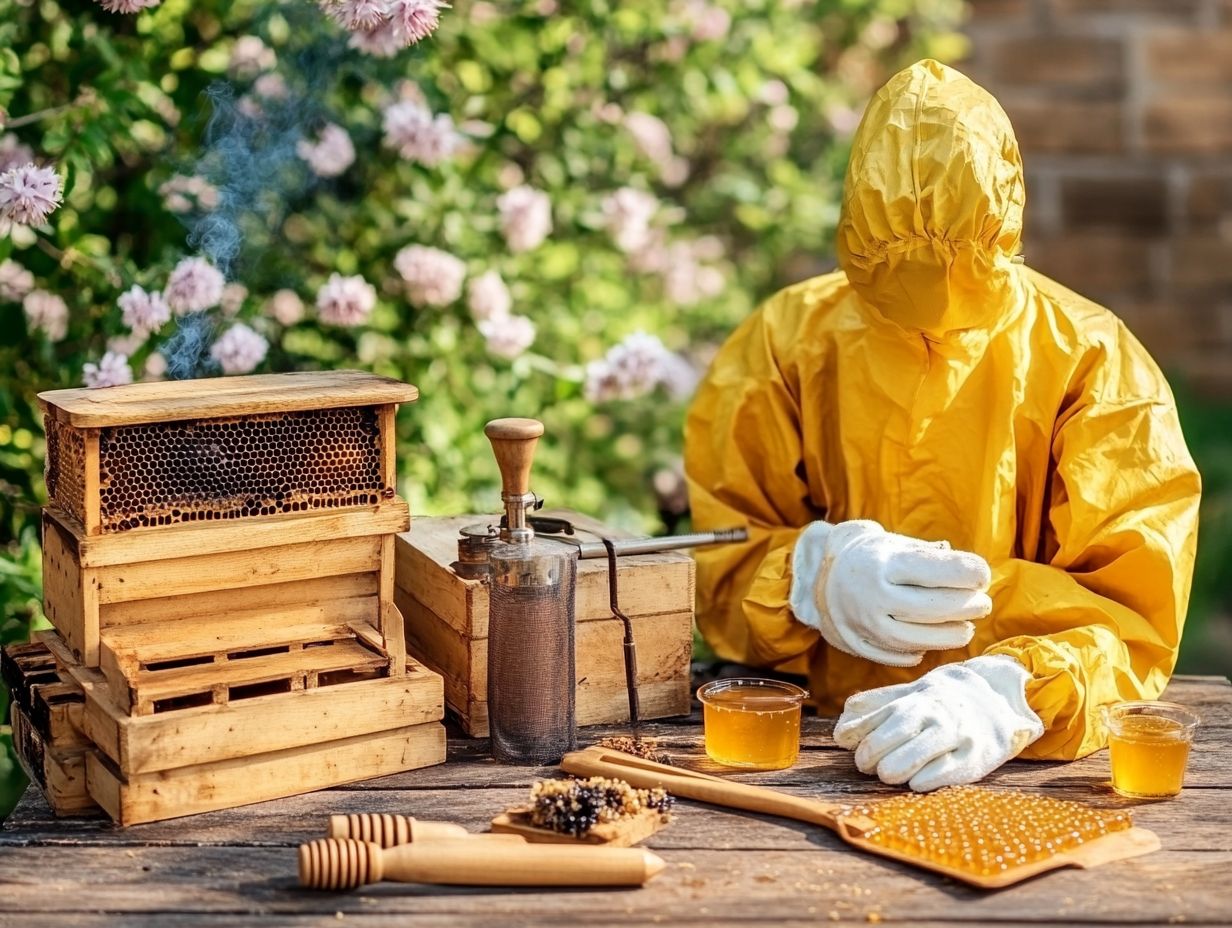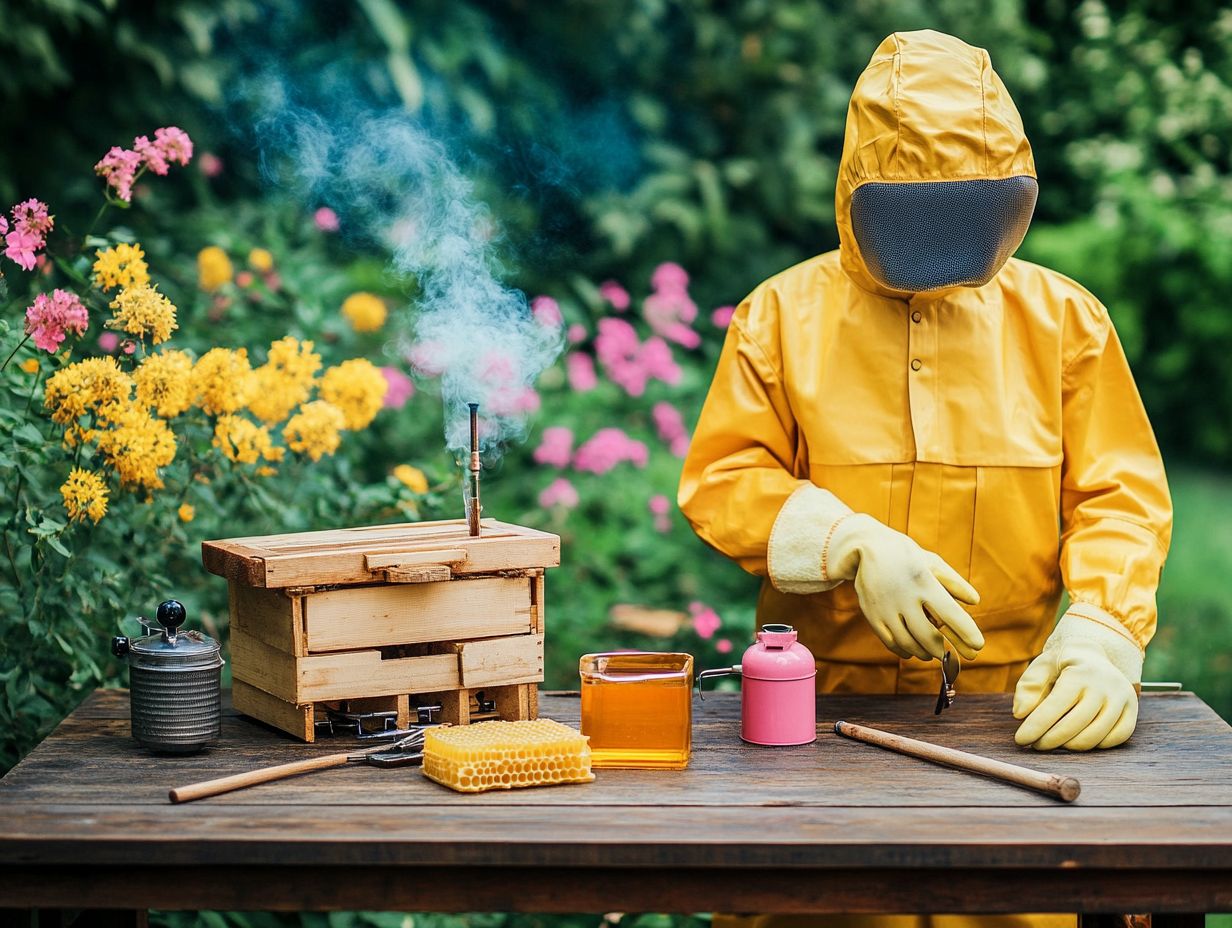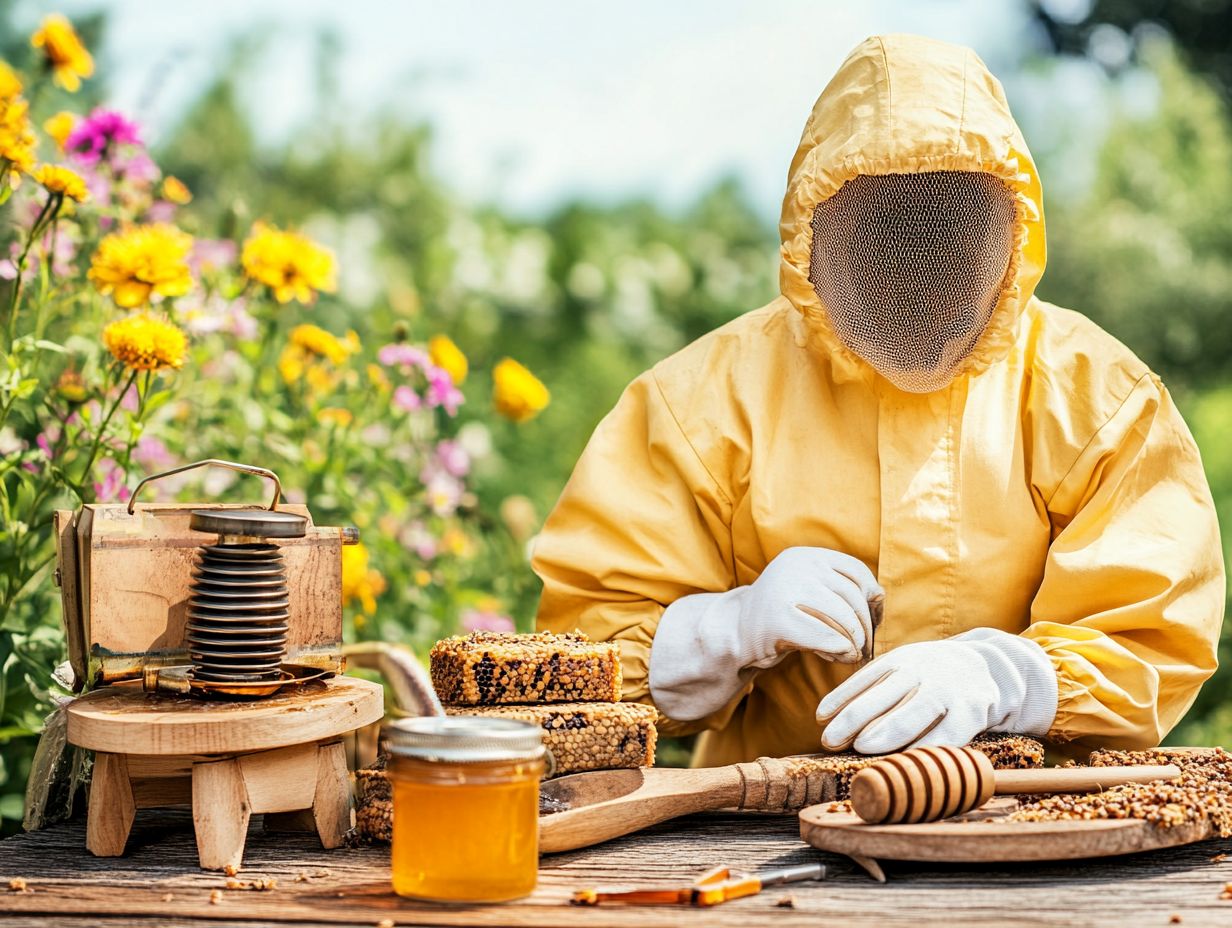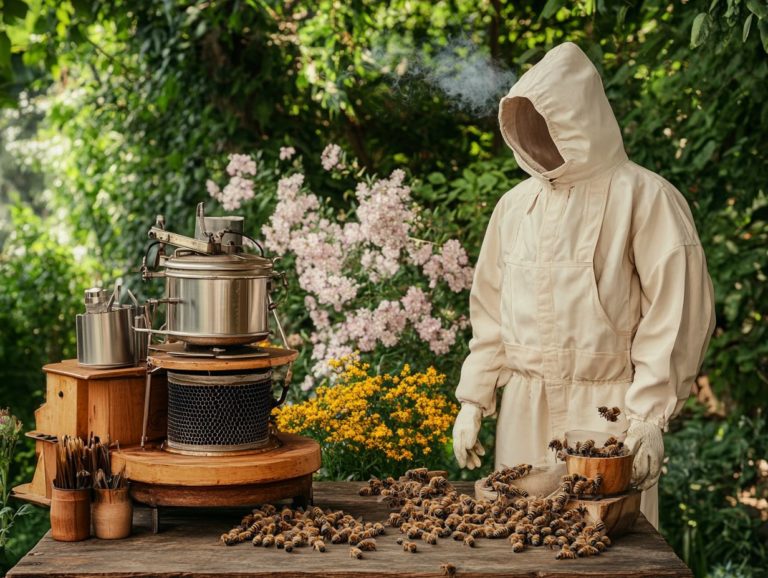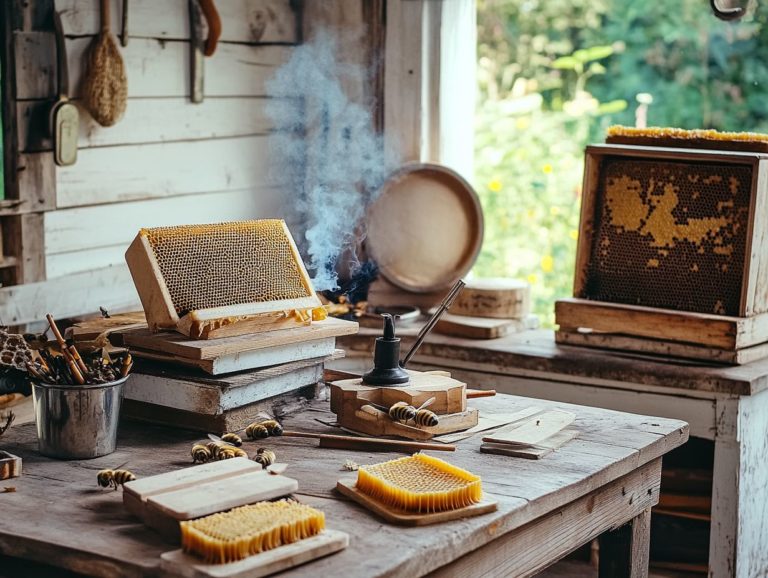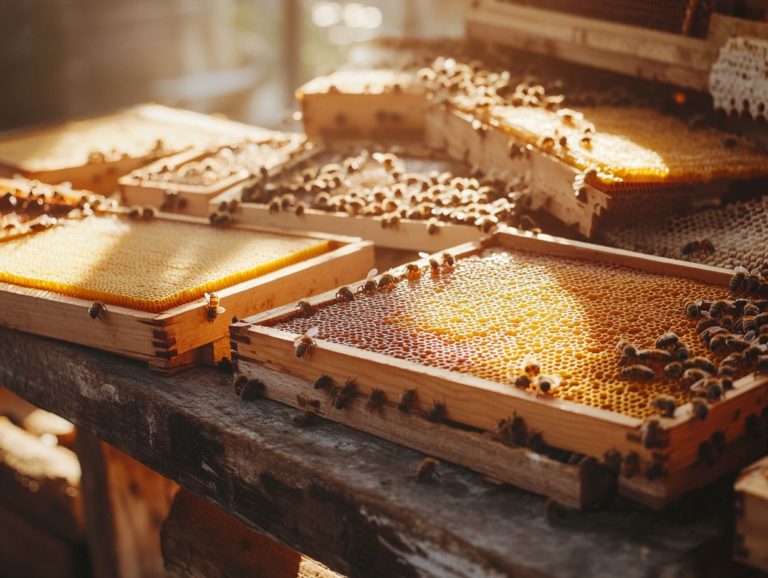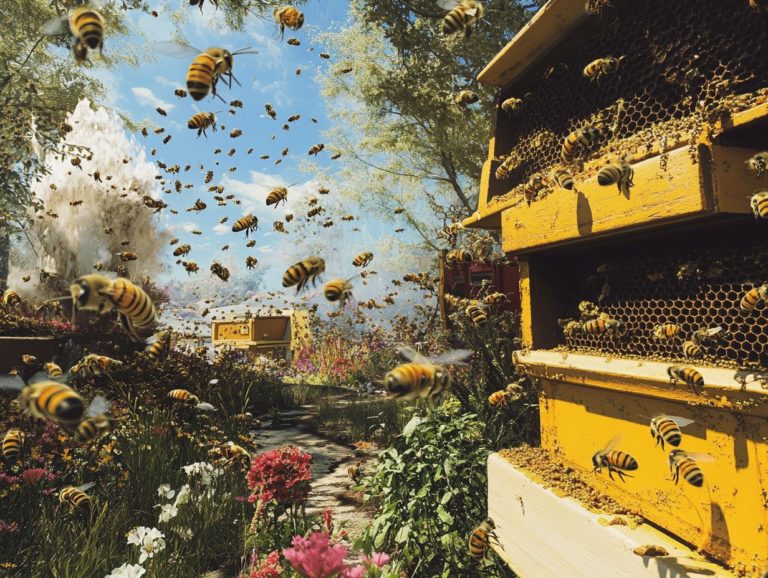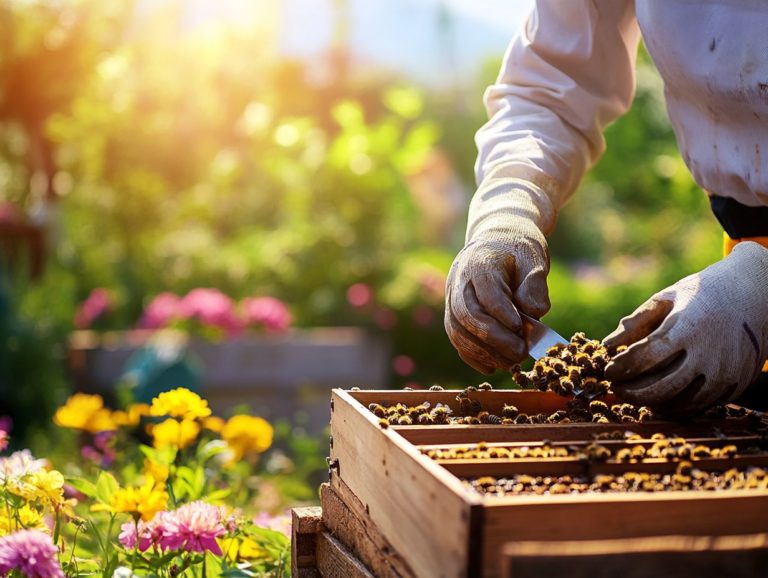Must-Have Equipment for Beekeeping in Summer
Beekeeping presents an incredibly rewarding hobby, particularly during the lively summer months when the bees are buzzing with activity.
Equipping yourself with the right tools is essential not only for your safety but also for the health of your hive. From protective gear to specialized tools like honey extractors and queen excluders, this guide will illuminate the must-have equipment for successful summer beekeeping.
Whether you’re a seasoned beekeeper or an intrigued newcomer, grasping the tools at your disposal can significantly enhance your beekeeping journey and efficiency.
Let’s dive into the essential gear, explore tips for selecting the right equipment, and identify common pitfalls to steer clear of along the way.
Contents
- Key Takeaways:
- 1. Protective Gear
- 2. Smoker
- 3. Hive Tool
- 4. Bee Brush
- 5. Honey Extractor
- 6. Uncapping Knife
- 7. Queen Excluder
- 8. Feeder
- 9. Swarm Catcher
- 10. Beekeeping Suit
- How to Choose the Right Equipment for Your Beekeeping Needs?
- What Are the Essential Tools for Beekeeping in Summer?
- What Are Some Optional Equipment for Beekeeping in Summer?
- How Can Proper Equipment Improve Beekeeping Efficiency?
- What Are Some Tips for Maintaining and Cleaning Beekeeping Equipment?
- What Are the Common Mistakes to Avoid When Purchasing Beekeeping Equipment?
- Frequently Asked Questions
- What are the must-have equipment for beekeeping in summer?
- Why do I need a hive for beekeeping in summer?
- Do I need protective gear for beekeeping in summer?
- What is the purpose of a smoker in beekeeping?
- Why do I need a hive tool and bee brush for beekeeping in summer?
- Is a honey bee feeder necessary for beekeeping in summer?
Key Takeaways:
- Wear proper protective gear, like a beekeeping suit, to stay safe from stings.
- Use a smoker to calm the bees for easier hive inspections.
- A hive tool is essential for prying apart frames and removing beeswax.
1. Protective Gear
In the realm of backyard beekeeping, having the right protective gear is essential for your safety and comfort, especially if you’re a beginner like Adam and Leslie Martin from Culleoka, Tennessee. Proper beekeeping gloves, suits, and jackets shield you from potential stings while boosting your confidence during hive interactions.
Understanding the importance of protective equipment can enhance your beekeeping experience. This allows you to concentrate on essentials like hive inspections and honey harvesting without the anxiety of injury.
High-quality beekeeping gloves are a must, offering a reliable barrier against bites while granting you the dexterity needed to handle bees and tools with precision. Beekeeping suits are also important as they provide protection. Crafted from breathable yet sting-resistant materials, they offer comprehensive protection while navigating the challenges of your hives—especially the Langstroth hive, which is the most common type of beehive used.
This becomes particularly critical when tackling pests like Varroa mites, a harmful parasite that can affect bee colonies, where careful management is vital for colony health.
Wearing the appropriate gear gives you the power to maintain calmness during inspections, ensuring you can respond effectively to any situation. Ultimately, this fosters a safer and more enjoyable beekeeping journey.
2. Smoker
A smoker is a critical tool in your beekeeping arsenal, expertly designed to calm bees during hive inspections. This makes it invaluable for managing Varroa mites and ensuring a seamless workflow when tending to your Langstroth hive.
You can find various types of smokers, such as bellows smokers and electric smokers, each offering unique advantages that can elevate your beekeeping experience.
To harness the full potential of a smoker, it’s crucial to establish the right smoke output. Experimenting with fuels like pine needles, cardboard, or seasoned wood chips will help you create consistent, cool smoke. This technique calms your bees, making inspections smoother and less stressful. By maintaining this tranquil environment, you minimize bee aggression, allowing you to inspect your hives with greater comfort and efficiency.
Using a smoker properly is essential to ensure your safety and that of your bees during inspections.
3. Hive Tool
The hive tool is a critical addition to your beekeeping kit, designed to help you manipulate frames, scrape off excess wax, and simplify the honey harvesting process with remarkable ease.
Among the various options available, frame grippers stand out as particularly invaluable. They allow you to lift and maneuver frames effortlessly, significantly reducing the chances of crushing bees during inspections. Pairing these tools with a bee smoker can further enhance your efforts by calming the colony, enabling you to conduct thorough examinations without disturbance.
Using the right hive tools not only streamlines your hive maintenance routine but also elevates the overall efficiency of your inspections. By arming yourself with these specialized implements, you pave the way for a smoother workflow, ultimately cultivating healthier colonies and yielding more bountiful honey harvests.
4. Bee Brush
A bee brush is an essential tool for your gentle way to handle bees during hive inspections. It allows you to carefully maneuver bees off frames without causing any harm, which is particularly important when checking for Varroa mites—tiny pests that can harm bees.
You’ll find various types of bee brushes available, each tailored for specific applications. Soft-bristled brushes are ideal for delicate handling, minimizing stress on the bees. On the other hand, firmer brushes can be effective when you need to move bees with a bit more assertiveness.
When you use a bee brush, stay calm and apply only gentle pressure. Instead of swiping at the bees, stroke them to help keep them relaxed. Timing is also vital; conducting your inspections on warmer, sunnier days often results in more docile bees.
Keep in mind that your goal is to ensure a safe and productive experience for both you and the bees!
5. Honey Extractor
The honey extractor is an essential tool for you as a beekeeper, enabling efficient honey harvesting by extracting honey from the comb without damaging the beeswax container or disrupting the hive’s structure.
Honey extractors come in various types, including manual and electric models. If you’re just starting out, a manual extractor is a budget-friendly choice, providing a hands-on experience and a deeper connection with your bees. However, if your operation is larger, electric extractors can drastically cut down on harvesting time and effort.
The honey extraction process involves removing frames from the hive, uncapping them, and then spinning them in the extractor, which efficiently separates the honey from the wax. To ensure a successful harvest, it’s crucial for you to consider the timing—selecting periods when the honey is ripe—and always leaving enough honey for the bees to thrive during the off-peak seasons.
6. Uncapping Knife
An uncapping knife is critical for your honey harvesting endeavors, enabling you to effectively remove the wax cappings from honeycomb cells before employing a honey extractor to gather that delightful liquid gold.
Today, a variety of uncapping knives are available, tailored to suit different preferences and needs. You can opt for electric knives, which provide a swift and efficient method for slicing through wax, or choose manual knives for a more traditional touch.
To achieve the best results, consider warming the knife slightly to melt the wax, and use smooth, even strokes for clean cuts. Uncapping is not just a task; it’s a vital step in the honey harvesting process that significantly enhances your yield during extraction.
7. Queen Excluder
A queen excluder is an essential element in a Langstroth hive, designed to prevent the queen from laying eggs in the honey supers. This helps keep your honey pure and uncontaminated.
This specialized grid allows worker bees to move freely while confining the queen to the areas meant for raising baby bees. By utilizing a queen excluder, you can effectively manage your hive’s productivity, ensuring that the honey stored in the supers remains pure and uncontaminated.
It proves particularly advantageous during honey flow periods, encouraging the bees to concentrate on nectar collection rather than brood production. Knowing the right time to install and remove the excluder can significantly enhance your honey harvest, setting the stage for optimal hive conditions.
8. Feeder
A honey bee feeder is an essential tool in your beekeeping arsenal. It ensures that your bees have ample access to food, especially during critical times like spring buildup and fall preparation in your backyard apiary.
Familiarizing yourself with the various types of feeders available can significantly enhance the overall health and productivity of your colonies. Options like top feeders, entrance feeders, and jar feeders each serve distinct roles and should be chosen based on the season and specific needs of your bees.
For instance, in the spring, syrup feeders can effectively stimulate brood production. In the fall, fondant or candy boards can provide the important energy supply needed for winter survival.
Adopting best practices also means regularly checking feeder levels and maintaining cleanliness to avoid contamination. This ultimately fosters healthier and more vigorous hives!
9. Swarm Catcher
A swarm catcher is a critical asset in your beekeeping supplies. It helps you capture swarming bees and introduces them into a new Langstroth hive for optimal management and productivity.
This process is vital not just for expanding your backyard beekeeping, but also for ensuring the overall health of the bee population. Timing is everything when it comes to swarm catching. Acting swiftly upon spotting a swarm minimizes stress on the bees and greatly enhances your chances of a successful capture.
You have various methods at your disposal, such as:
- Bait hives
- Swarm traps
- Catching them with a net
Each method offers a unique strategy. You can also use tools like smoker fuel to draw swarms in your direction.
For even greater success, take the time to observe swarm behavior beforehand. Prepare by having all necessary beekeeping kit ready at hand. This foresight will pave the way for a smoother and more efficient capture process!
10. Beekeeping Suit
A high-quality beekeeping suit is essential for you as a beekeeper. It provides both protection and comfort while working with bees, including beekeeping gloves and a beekeeping jacket. This allows you to focus on your tasks without worrying about stings.
There’s a variety of beekeeping suits available to cater to your individual preferences and needs. You can choose from full suits that cover you from head to toe or lighter jackets perfect for warm weather or casual inspections.
Full suits typically come with elastic cuffs and a fitted hood, ensuring a snug fit that minimizes your exposure to bee stings. On the other hand, beekeeping jackets offer flexibility and breathability, making them a favored choice for many beekeepers—especially beginners.
Selecting the right material is equally important when choosing beekeeping clothing. Options like cotton and synthetic blends can significantly affect your comfort in various temperatures, allowing you to work efficiently while maintaining optimal protection from potential hazards.
How to Choose the Right Equipment for Your Beekeeping Needs?
Choosing the right equipment for your beekeeping journey is crucial, especially as a beginner. It sets the stage for a successful and enjoyable experience as you delve into the fascinating realm of beekeeping supplies, honey harvesting, and hive management.
To embark on this adventure, you should first assess your specific needs. Consider factors like your preferred hive type, the species of bees you’re considering, and your personal goals within the hobby, including whether you’ll use a Langstroth hive or a Layens. Your focus on honey production, pollination, or educational pursuits will greatly influence your equipment choices.
For rookies, essential tools include:
- Smoker
- Hive tool
- Protective clothing
These are integral components for maintaining safety and efficiency. As you assemble your comprehensive kit, remember that it’s not just about snagging these basics. You’ll also want to consider additional items like honey bee feeders and varroa mite treatments, which are vital for sustaining healthy bee colonies.
What Are the Essential Tools for Beekeeping in Summer?
During the summer months, essential tools for your beekeeping endeavors—such as the hive tool, smoker, and honey bee feeder—are crucial for maintaining hive health and ensuring a bountiful honey harvest.
Each of these tools serves a specific purpose that greatly enhances the overall well-being of your hive. The hive tool is critical for accessing the frames and managing hive maintenance, allowing you to inspect for pests or diseases (including varroa mites, harmful pests that can affect bee colonies) with ease.
The smoker calms your bees during inspections, helping to temper any aggressive behavior that can flare up in warmer weather. Meanwhile, the honey bee feeder ensures that your colonies have a dependable food source, especially when nectar flow begins to wane.
For fantastic results, fire up that smoker generously! Check your hives in the morning when the bees are calmer, and ensure that feeders are clean and filled. This way, you’ll support healthy growth during those bustling high-activity periods.
What Are Some Optional Equipment for Beekeeping in Summer?
While certain tools are essential for your summer beekeeping, optional equipment like a honey extractor, queen catcher, and frame holder can elevate your beekeeping experience and boost your efficiency, particularly in managing larger operations or larger apiaries.
Investing in these additional tools can significantly streamline various tasks, making them more manageable and saving you precious time. For instance, a honey extractor not only speeds up honey harvesting but also protects the integrity of the honeycomb, ensuring future honey production remains unharmed.
A queen catcher allows you to easily locate and manage the queen, which is vital during hive inspections or when re-queening. Meanwhile, a frame holder serves as an extra pair of hands when you’re juggling multiple frames, preventing them from tipping or getting damaged.
These tools are game-changers during peak honey flow seasons or when managing larger apiaries, optimizing both your productivity and the health of your hives, especially in the context of beekeeping supplies.
How Can Proper Equipment Improve Beekeeping Efficiency?
Proper equipment can significantly elevate your beekeeping efficiency, enabling you to conduct hive inspections swiftly, manage your colonies effectively, and maximize honey harvesting with minimal disruption.
When you utilize specialized tools like a frame gripper, lifting and maneuvering heavy frames becomes a breeze, reducing both physical strain and the time spent during examinations. This efficiency shines, particularly when managing multiple hives, making quick access to the brood chamber essential.
Hive tools are critical for maintaining a smooth workflow. Their sharp edges assist in prying apart frames, removing propolis, and scraping the hive bottom, contributing to a more organized operation, especially when considering beekeeping supplies.
By equipping yourself with the right tools, such as a bee brush, you can ensure that your practices not only boost productivity but also enhance the overall health and management of your bee colonies.
Get ready for a successful summer of beekeeping—equip yourself with these essential tools today!
What Are Some Tips for Maintaining and Cleaning Beekeeping Equipment?
Regularly maintaining and cleaning your beekeeping equipment is essential for enhancing the longevity of your tools and ensuring a thriving environment for your bees. This includes effective bee brushes and tools for managing hives.
By weaving routine inspections and thorough cleaning sessions into your beekeeping agenda, you can prevent the accumulation of harmful residues and pathogens. These threats can endanger the health of your hive, especially those spread by varroa mites.
It’s crucial to give extra attention to tools for managing hives, honey extractors, and bee brushes, as these items come into direct contact with both your bees and honey, including beeswax containers for storage.
Keeping your tools for managing hives free from rust and dirt not only makes them easier to use but also safeguards against contamination. This is especially important when working with high-quality honey.
Consistently cleaning honey extractors and ensuring that bee brushes are devoid of debris will help maintain optimal working conditions. This allows you to focus on what truly matters: nurturing your colonies and harvesting high-quality honey.
What Are the Common Mistakes to Avoid When Purchasing Beekeeping Equipment?
As a beginner in beekeeping, you may face common pitfalls when purchasing equipment. These can lead to unnecessary expenses and a less-than-ideal experience in managing your hives. This is particularly true if you overlook essential items like smokers or tools for managing hives.
One frequent misstep is opting for low-quality supplies that seem budget-friendly at first. These can quickly turn into a financial headache due to repairs or replacements down the line, especially regarding beekeeping gloves or other critical beekeeping clothing.
Overlooking essential tools like smokers, tools for managing hives, and protective clothing, including beekeeping suits, can significantly hinder your ability to work safely and efficiently.
It’s exciting to consider the specific needs of your unique setup! Ensure you invest in equipment that promotes a healthy and productive environment for your bees, including the right honey extractor.
Take the time to research and consult with seasoned beekeepers. This will empower you to make informed purchasing decisions and lay a solid foundation for your beekeeping journey—especially through resources like Facebook or Craigslist for local supplies.
Frequently Asked Questions
What are the must-have equipment for beekeeping in summer?
The essential equipment for beekeeping in summer includes a hive, protective gear, smoker, hive tool, bee brush, and honey bee feeder.
Why do I need a hive for beekeeping in summer?
A hive is the home for your bees and provides a safe and secure environment for them to build their comb and store honey.
Do I need protective gear for beekeeping in summer?
Yes! Protective gear such as a bee suit, veil, and beekeeping gloves are necessary for beekeeping in summer to avoid getting stung by the bees.
What is the purpose of a smoker in beekeeping?
A smoker is used to calm the bees and make them less likely to sting. This is essential when inspecting the hive or collecting honey.
Why do I need a hive tool and bee brush for beekeeping in summer?
A hive tool is used to open and manipulate the hive. A bee brush is used to gently move bees away from frames and other areas during hive inspections.
Is a honey bee feeder necessary for beekeeping in summer?
A feeder is not essential, but it can be helpful in providing supplemental nutrition for the bees during the busy summer months when they are actively building their colony and producing honey.

